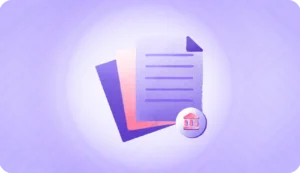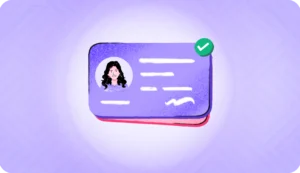Banks must know the identity of their clients to ensure the safe handling of money. This is where the identity verification process steps in. It’s a straightforward but vital procedure that ensures a person opening a bank account online is truly who they claim to be.
In this blog, we’ll discuss the bank identity verification process along with a detailed list of legal documents required in the US and India for opening an account online or in person.
Compliance regulations you should know
Following are the compliance regulations for financial institutions you should know.
Customer identification program (CIP)
Imagine you’re at a bank opening a new account. They’ll first go through a process called the Customer Identification Program, or CIP. This isn’t just paperwork; it’s a mandatory step for banks to prevent fraud and document forgery. They’ll ask for your name, date of birth, address, and an identification number—usually from a government-issued ID like a passport or driver’s license. It’s the bank’s way of saying, “We need to make sure you’re you.”
Customer due diligence
But it doesn’t stop there. Banks then move to a phase called Customer Due Diligence. This is where they dig a bit deeper, ensuring that their customers aren’t just who they say they are, but they’re not involved in any shady business. They might look at your job, your financial history, or how you plan to use your account. This isn’t nosiness; it’s due diligence. It’s about ensuring the bank isn’t used as a tool for money laundering or funding bad stuff.
When do banks require KYC and identity verification?
Knowing who is behind a transaction or an account is as vital for a bank as knowing how to manage money. Bank identity verification through the KYC process is not a one-time affair; it’s an ongoing commitment to ensure the legitimacy and safety of banking operations. Let’s explore when exactly banks put KYC and identity verification into action.
Transaction verification
Every time you make a big move with your money, banks take a moment to ensure it’s really you. This is transaction verification. Whether wiring a large sum or making an international purchase, the bank uses KYC checks to ensure the transaction isn’t fraudulent. It’s like a financial checkpoint that keeps your money on the right track.
Opening bank accounts
The moment you decide to open a new savings or checking account, bank identity verification kicks in. It’s the first handshake between you and the bank, establishing a foundation of trust. Banks are legally required to collect and verify your identity not only to know you but also to protect you from potential identity theft right from the start.
Customer onboarding
Onboarding isn’t just about welcoming you to the bank; it’s about integrating you into the banking system safely and securely. During onboarding, banks use KYC to go beyond just knowing your name—they learn about your financial behavior and goals, ensuring they offer services that match your needs.
Fraud prevention
In a world where fraudsters are constantly looking for loopholes, consistent KYC checks are the bank’s way to reduce fraud and stay one step ahead. By verifying identities regularly, banks can detect suspicious patterns and prevent fraud before it hits your account. An ongoing vigilance secures your finances and the banking system at large.
Read more: Top 6 identity verification methods
How do banks perform identity verification?
Banks are at the forefront of using technology to ensure they know their customers well. They employ various methods to perform bank identity verification on users, ensuring security and compliance with global regulations.
Document verification
The process starts when you provide your ID. Banks conduct document verification, running the details through government databases. It’s a meticulous check to ensure everything is in order, from your name to birth date.
Read more in our ultimate guide to document verification.
Optical character recognition (OCR)
With OCR technology, banks efficiently convert your ID documents into digital biometric data. This fast-tracks the verification process by extracting crucial information for further checks.
Facial recognition
Facial recognition technology is a high-tech tool that compares your live photo or a selfie with the one on your ID. This AI-powered process is becoming a standard part of bank identity verification.
Video KYC
Banks are now adopting Video KYC to add a real-time, personal layer to the verification process. This involves a live agent who guides you through the process over a video call, ensuring that the person creating the account is the one in the identification documents.
Biometric authentication
For an extra layer of security, banks often turn to biometric verification for authentication. This method uses unique biological traits like fingerprints or facial features, confirming that customers are genuinely who they say they are.
To understand how these technologies create a secure banking environment, learn about the digital identity verification methods and solutions used in finance.
Essential documents for opening a bank account
Whether you apply online or in person, in order to open a bank account, you must provide documentation to the bank, credit union, or financial institution and meet the necessary eligibility requirements.
ID documents required to open savings and checking bank accounts in the US.:
Government-Issued ID
Your primary form of identification will typically be a government-issued ID, which links your face to your name. This government issued identification can be your driver’s license, state-issued ID, or passport.
Social security card
A valid Social Security Number (SSN) is crucial for complete identity verification in the United States. A Social Security card is the standard document required to verify your SSN when opening a bank account.
Proof of address
Banks also need to confirm your residence. You might provide a utility bill, credit card statement, lease agreement, or mortgage statement. Any official document, including your rental agreement, with your name and current address will suffice.
Taxpayer identification number (TIN)
The bank will require you to provide your Taxpayer Identification Number (TIN) to report your taxes to IRS.
If you are not a U.S. citizen, some banks and credit unions may still allow you to open an account. However, you will need to provide one or more of the following documents:
– Passport number and country of issuance
– Alien identification card number
– Another government-issued individual tax identification number from the issuing country, a document containing a photo and address; this should offer proof of your nationality or residence.
ID documents required to open business accounts in the US.:
To open a business account, you may need to provide some additional documents. These include the Employer Identification Number (EIN) or Social Security number for sole proprietorship, business formation documents, ownership agreements, and business license.
Accepted ID documents for opening a bank account in India:
ID proof
- PAN card
- Aadhaar card
- Voter ID
- Passport
- Driving license
- Employee ID
- Central or state government-issued photo ID proofs
- NREGA job card
Address proof for bank account
- Voter ID
- Utility bill (electricity, gas, water, telephone)
- Passport
- Driving license
- Recent account statement
- Bank passbook
- Ration card
- Aadhaar card
- A letter attested (stamped/signed/recognized) by a gazetted officer or approved public authority for address verification
If you’re opening a joint account, you’ll need all these documents for both the account holders. Most banks now provide digital options to ease the process of form submission.
To simplify the KYC process for account applicants, the Reserve Bank of India has relaxed the rules for submitting documents. If you provide one of the following documents as bank account proof, you only need to provide any one of the documents mentioned below for proof of identity and proof of address:
- Passport
- Driving license
- Voters ID card
- PAN card
- Aadhaar letter from UIDAI or Aadhaar card
- NREGA job card with State Government official signature
Usually, banks require you to submit address proof for your current and permanent addresses separately. However, with the new relaxation, if your current and permanent address in the address proof differs, you only need to submit a declaration form with the current address. KYC documents aren’t necessary to be submitted again when you move your bank account to a local branch of the same bank.
If the bank classifies you as a low-risk customer, you don’t need to submit one of the officially valid documents. You can provide any one of the below within six months of opening the account:
- Photo ID proof issued by central/state government, statutory/regulatory authorities, public sector undertakings, scheduled commercial banks, and public financial institutions;
- A gazetted officer’s letter with a duly certified photograph of the person.
For self-help groups (SHGs), KYC documents for all members are not needed. KYC documents have to be submitted only to the officials. In addition, international students can submit their KYC documents as bank account proof within one month of opening a bank account.
Traditionally, you have to visit the branch with which you want to open your savings account and submit photocopies of proof of bank account. Now, the KYC process has become digital. E-KYC allows you to submit the documents from the comfort of your home.
The savings bank account opening can be completed online by submitting the online application form and e-KYC. You can submit a self-portrait with your documents or a self-portrait video with your documents based on the requirement of your bank for identity verification services.
Some banks ask you to upload the documents using their online platform while filling out the online application. Once the documents are submitted online, you must wait a few hours to a day for verification.
Conclusion
HyperVerge offers a suite of AI-powered financial verification solutions designed to streamline the onboarding process for banks and financial institutions. Their technology ensures compliance, enhances security, and provides a seamless customer experience. With cutting-edge solutions like real-time ID verification, facial recognition match, and video KYC, HyperVerge aids in reducing fraud and improving operational efficiency.
Ready to transform your customer onboarding and verification processes? Experience the future of financial verification with HyperVerge’s AI-powered identity verification solutions.





